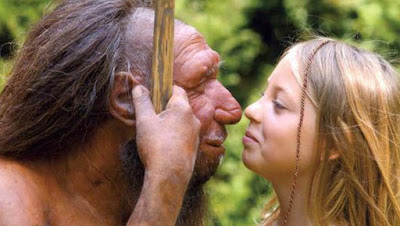Neanderthals and Humans - Archaeology Neanderthals and Humans
Neanderthals or Neandertals UK /niˈændərˌtɑːl/, us also /neɪ/-, -/ˈɑːndər/-, -/ˌtɔːl/, -/ˌθɔːl/ were a species or subspecies of human in the genus Homo which became extinct around 40,000 years ago.
Neanderthals and Humans Interbred Far Early Than Thought
 |
| Neanderthals and Humans Interbred Far Early Than Thought |
A new genetic study suggests that Neanderthals and modern humans interbred well before scientists have previously supposed. Since 2010, DNA studies have consistently shown that humans and Neanderthals must have interbred around 47,000-65,000 years ago, when modern humans are known to have emigrated from Africa. But recent sequencing of the DNA of the so-called “Altai Neanderthal," using a tiny toe bone fragment unearthed in a cave in Siberia's Altai mountains, shows its ancestors also interbred with modern humans who left Africa tens of thousands of years before the famous "Out of Africa" migration dating to around 60,000 years ago. "The signal we're seeing in the Altai Neanderthal probably comes from an interbreeding event that occurred...a little more than 100,000 years ago," said Cold Spring Harbor Laboratory geneticist Adam Siepel in a press release. This group of modern humans probably broke off from other human populations around 200,000 years ago, and went extinct sometime after interbreeding with Neanderthals. To read more about Neanderthals, go to "Should We Clone Neanderthals?"
Neanderthals and Humans Likely Bred in the Mideast
 |
| Neanderthals and Humans - Archaeology Neanderthals and Humans |
Neanderthals and modern humans may have interbred much earlier than thought, with ancient liaisons potentially taking place in the Middle East, researchers say.
This finding supports the idea that some modern humans left Africa long before the ancestors of modern Europeans and Asians migrated out of Africa, scientists added.
The Neanderthals were once the closest relatives of modern humans, living in Europe and Asia until they went extinct about 40,000 years ago. Scientists recently discovered that Neanderthals and modern humans once interbred; nowadays, about 1.5 to 2.1 percent of DNA in people outside Africa is Neanderthal in origin. Last week, researchers reported that the genetic legacy of the Neanderthal has had a subtle but significant impact on modern human health, influencing risks for depression, heart attacks, nicotine addiction, obesity and other problems.
Based on the fossil record, Neanderthals diverged from modern humans at least 430,000 years ago. Previous analysis of a Neanderthal genome from a cave in the Altai Mountains in Siberia suggests the two lineages diverged between about 550,000 to 765,000 years ago. Subsequent research suggested that interbreeding led Neanderthals to contribute genetic material to modern humans outside Africa about 47,000 to 65,000 years ago.
Neanderthals And Humans Interbred 100,000 Years Ago: Study
Neanderthals may have been mating with modern humans 100,000 years ago, tens of thousands of years earlier than previously thought, a new study based on several different methods of DNA analysis has found.
Scientists provide the first genetic evidence of a scenario in which early modern humans left the African continent and mixed with now-extinct members of the human family prior to the migration "out of Africa" of the ancestors of present-day non-Africans, less than 65,000 years ago.
"It's been known for several years, following the first sequencing of the Neanderthal genome in 2010, that Neanderthals and humans must have interbred," said Professor Adam Siepel, from Cold Spring Harbor Laboratory (CSHL) in US.
"But the data so far refers to an event dating to around 47,000-65,000 years ago, around the time that human populations emigrated from Africa. The event we found appears considerably older than that event," said Professor Siepel.
"One very interesting thing about our finding is that it shows a signal of breeding in the 'opposite' direction from that already known," he said.
Neanderthals and Humans - Archaeology Neanderthals and Humans
 Reviewed by Unknown
on
17:19
Rating:
Reviewed by Unknown
on
17:19
Rating:
 Reviewed by Unknown
on
17:19
Rating:
Reviewed by Unknown
on
17:19
Rating:


Không có nhận xét nào: